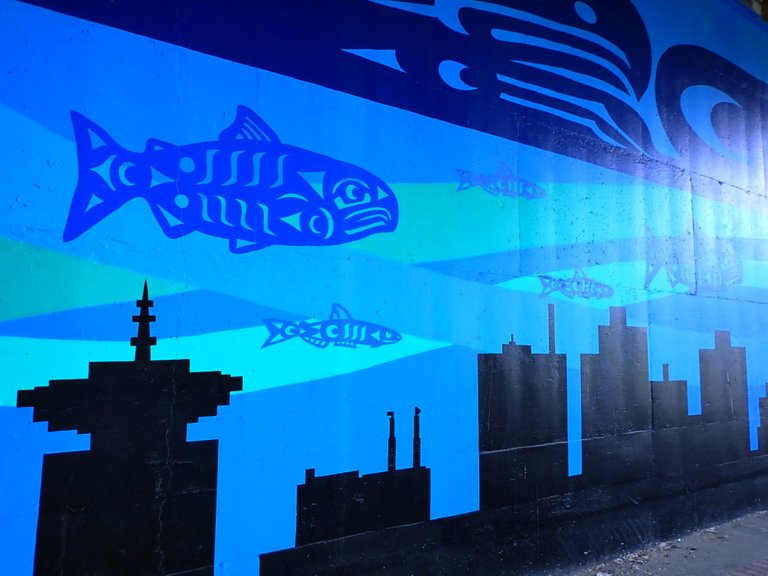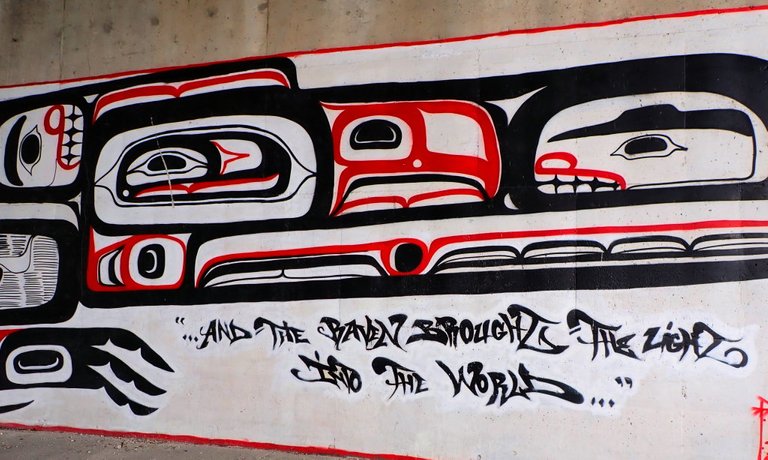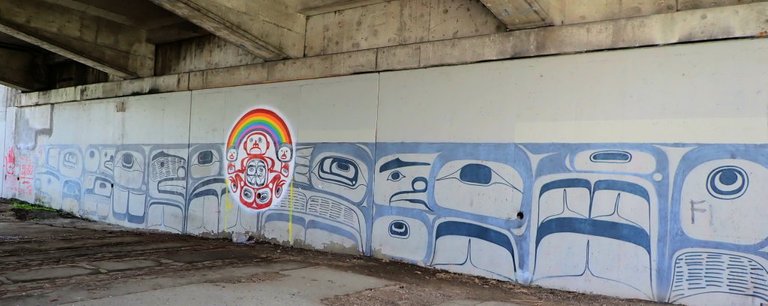
When the Earth was new, people settled across the land and thrived in the Pacific Northwest. Soon food became scarce, however, and conflicts ensued. The elders began having bad dreams of a great flood, and although not everyone believed them, they convinced a few people to help them prepare by making canoes and other gear from cedars. The rain fell, and as prophesied, the land was flooded. Even the mountains. Those who believed got saved, and those who didn’t, got what was coming to them. When the waters receded, the people returned to the land and to their old ways, including conflict. It was clear that harmony could not be found among the people, and so the different tribes were created.
This is the (paraphrased) Salish version of the legend of the Great Flood, found among indigenous cultures of the Pacific Northwest. The story lends itself to great imagery and artist Wade Baker displayed elements of this story in his mural entitled “The Waters are Rising”, which is located beneath the southern portion of the Granville bridge. In this version of the story, the artist uses the iconography of the Thunderbird, who warns of dangers ahead, salmons as knowledge keepers, and Eulochon fishes as learners (source).

On the other side of Mr. Baker’s mural lies controversy. In 2008, another mural called And the Raven Brought the Light was painted by artists from the Haida nation. In 2019, the city announced that it would “decommission” said mural and paint over it with the work of artists from other indigenous nations local to the area (source). As you can imagine, a lot of backlash ensued, particularly in social media. That was three years ago, and from the looks of it, the raven still is standing on the wall.

The character of Raven appears on some indigenous legends. In the Haida version of the legend, the mischievous raven impregnates himself into a woman and then steals the light of the universe from her father, who kept it locked up in a box. This creation myth explains how light came to be in the world and allowed Raven to grope about without “bumping into things in the dark.” (source)

Another mural nearby...

All images by @litguru
What always gets me is that how many cultures have a flood story. Either it's quite ordinary, as there's always going to be a flood in any country, or it was such a gargantuan flood it totally covered every nation.
The murals are great.
My rational mind tells me that this is just a common experience we all share mixed with our propensity to exaggerate. When a storm hits, it feels as if the entire world is drenched. This would be particularly so in the olden days when they lacked mass communications and weather monitoring systems. As Jung might put it, flood stories are expressions of the collective unconscious.
On the other hand, I love a good yarn. Graham Hancock has written and spoken extensively about flood myths throughout the world. He believes that some cosmic event occurred that caused a catastrophic flood in the ancient past. He's a compelling writer and speaker. If you would like to read more about the flood until your eyes roll to the back of your head, check out the following article:
NOAH’S FLOOD The Cosmic Connection
Thank you for visiting!
I love the Haida stories, I have a collection of them in a book. The raven story is my favorite.
Thanks for sharing this beautiful art! Is this in Vancouver?
Yes, it is Vancouver.
He's always up to some clever mischief. Plenty of crows and ravens around here in BC, so it's no wonder the stories are so prominent.
Thank you for reading @corvidae!